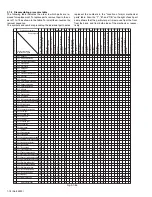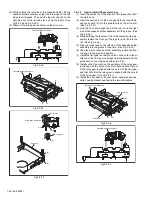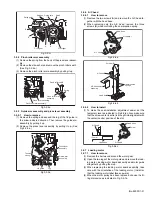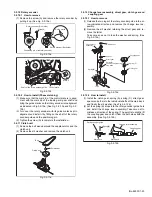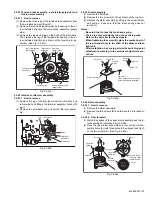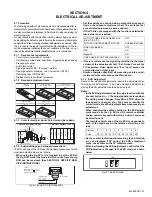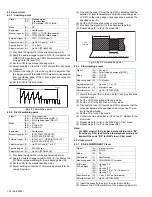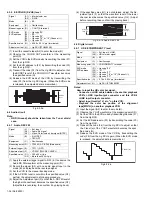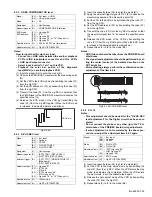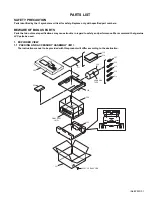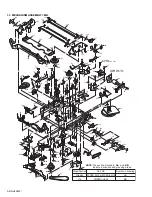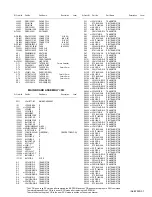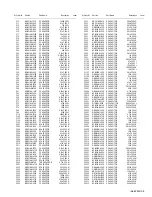
(No.82933)1-29
Fig.3-3-2b
3.3.3 Height and tilt of the A/C head
Note:
• Set a temporary level of the height of the A/C head in ad-
vance to make the adjustment easier after the A/C head has
been replaced. (See Fig.3-2-6c.)
(1) Play back the alignment tape (A).
(2) Apply the external trigger signal to D.FF (E), to observe the
AUDIO OUT waveform and Control pulse waveform at the
measuring points (D1) and (D2) in the ALT mode.
(3) Set the VCR to the manual tracking mode.
(4) Adjust the AUDIO OUT waveform and Control pulse wave-
form by turning the screws (1), (2) and (3) little by little until
both waveforms reach maximum. The screw (1) and (3) are
for adjustment of tilt and the screw (2) for azimuth.
Fig.3-3-3a
3.3.4 A/C head phase (X-value)
(1) Play back the alignment tape (A1).
(2) Apply the external trigger signal to D.FF (E), to observe the
V.PB FM waveform at the measuring point (D).
(3) Set the VCR to the manual tracking mode.
(4) Loosen the screws (4) and (5), then set the A/C head posi-
tioning tool to the innermost projected part of the A/C head.
(See Fig. 3-3-4a.)
(5) Turn the A/C head positioning tool fully toward the capstan.
Then turn it back gradually toward the drum and stop on the
second peak point position of the V.PB FM waveform out-
put level. Then tighten the screws (4) and (5).
(6) Perform the tracking operation and make sure that the
V.PB FM waveform is at its maximum.
If it is not at maximum, loosen the screws (4) and (5), and
turn the A/C head positioning tool to bring the A/C head to
a position, around where the waveform reaches its maxi-
mum for the first time. Then tighten the screws (4) and (5).
Note:
•
After adjusting, always perform the confirmation and re-
adjustment of the item 3.3.5.
Fig.3-3-4a
Fig.3-3-4b
3.3.5 Standard tracking preset
(1) Play back the alignment tape (A).
(2) Apply the external trigger signal to D.FF (E), to observe the
V.PB FM waveform at the measuring point (D).
(3) Confirm that the automatic tracking operation is completed.
(4) Set the VCR to the Auto adjust mode by transmitting the
code (F) twice from the Jig RCU. When the VCR enters the
stop mode, the adjustment is completed.
(5) If the VCR enters the eject mode, perform adjustment for
the audio control head phase (X-value) again.
Signal
(A)
• Alignment tape(SP, stairstep, NTSC) [MHP]
Mode
(B)
• PB
Equipment
(C)
• Oscilloscope
Measuring point (D1)
(D2)
• AUDIO OUT terminal
• TP4001 (CTL. P)
External trigger (E)
• TP111 (D.FF)
Adjustment part (F)
• A/C head [Mechanism assembly]
Specified value (G)
• Maximum waveform
Signal
(A1) • Alignment tape(SP, stairstep, NTSC) [MHP]
Mode
(B)
• PB
Equipment
(C)
• Oscilloscope
Measuring point (D)
• TP106 (PB. FM)
External trigger (E)
• TP111 (D.FF)
Adjustment part (F)
• A/C head base [Mechanism assembly]
Specified value (G)
• Maximum V.PB FM waveform
Adjustment tool (H)
• A/C head positioning tool [PTU94010]
(a) Guide roller
(b) Guide pole
Improper
Proper
Head base
A/C head
AUDIO OUT
CTL. P
(1)
(2)
(3)
Signal
(A)
• Alignment tape(EP, stairstep, NTSC) [MHP-L]
Mode
(B)
• PB
Auto adjust
Equipment
(C)
• Oscilloscope
Measuring point (D)
• TP106 (PB. FM)
External trigger (E)
• TP111 (D.FF)
Adjustment part (F)
• Jig RCU: Code “50”
Specified value (G)
• STOP mode
(Maximum V.PB FM waveform)
Adjustment tool (H)
• Jig RCU [PTU94023B]
A/C head positioning tool
Screw (4)
Screw (5)
Toward the drum
Toward the capstan
To the drum
A/C head
To the capstan
Head base
Alignment tape
[SP, stairstep]
played with the
SP head
Alignment tape
[EP(LP), stairstep]
played with the
EP(LP) head
Drum side
Control head position
Capstan side
X-value adjustment point
Maximum
Waveform output




